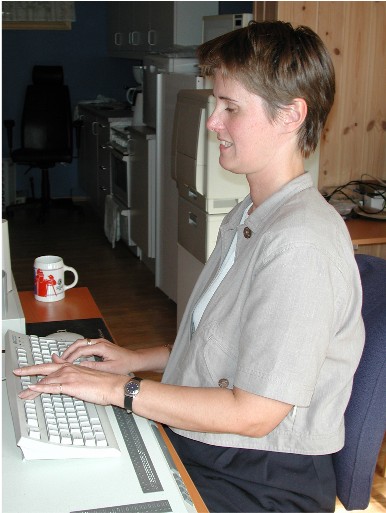ECDL Course via Distant Education
ECDL for visually impaired persons.
Story by: Morten Tollefsen - 15.01.2002
Insufficient training in using computers and standard software is particularly noticeable for blind and partially sighted persons. One of the main reasons is that visually impaired computer users are dependent on complicated assisting devices like Braille displays, artificial speech and screen enlargers. Course vendors usually do not have the necessary expertise to teach students using assisting devices and screen readers.
The ECDL (European Computer Driving License) is a standardized course in practical computer usage. MediaLT A/S, Datakortet A/S and several Norwegian organizations for the blind are working together to develop a suitable certification scheme, accessible learning materials and a training model for the visually impaired. The ECDL syllabus is not modified.
The project is funded by the Norwegian Research Council, Microsoft, Telenor and two Norwegian departments.
The successful outcome of the first distant education ECDL pilot course, for blind and visually impaired users, represents an important milestone in this work. All four participants were successful in attaining the ECDL. This pilot project, which started in January 2002, has been particularly exciting, as it is one of the first of its kind in which blind and visually impaired students receive online teaching. And the response to the announcement of the pilot project, through The Norwegian Society for the Blind, is yet another illustration of the acute lack of education in computer skills for the blind and partially sighted.
| Four applicants varying in age, background, occupation and geographical location, were selected to participate in the project. Anne Mai Lien has a Master of Science degree in Zoology and has set up a company offering services in water analysis. She lives in Asker just outside Oslo. Frank Hansen is also from the Oslo area and is employed as a HMS (Health, Environment and Safety) consultant with the Oslo municipality. Siri Bjerkestrand works as a student advisor at the University of Bergen, and Mons Åge Bjørndal is also from the Bergen area. The high level of motivation among the students was an important factor contributing to the successful outcome of the course. Ideally four or five courses could have been run simultaneously, so great was the interest in this type of course. Two of the participants are blind and two are partially sighted. |
|
The teaching consisted of online lectures, via a conference room. The Chatterbox program is used for speech based chatting over the Internet. The sound quality is good, and the product has other functions like file transfer, text chat, built in browser etc. ChatterBox is stable regarding screen readers and standard applications.
The lectures were given by Morten Tollefsen, who is blind himself, and in addition to a very high level of computer skills, also has long experience in the utilization of assisting devices by the blind and visually impaired. The great advantage of teaching online is that it allows the students to use the devices, such as Braille displays, artificial speech and screen enlargers, which they use in every day life at home and at work. An important supplement to the online lectures was communication via e-mail after each session, where questions could be effectively answered as problems arose.
Teaching and self-study were greatly facilitated by learning aids (tactile graphics) and literature that is accessible for the visually impaired. The computer books have been rewritten to include picture/figure descriptions, keyboard commands and alternative techniques. The seven set books are produced both in DAISY format and HTML. Special compendiums have been developed for different assisting devices. Three of the DAISY books include the full text and the remaining four are digital audio books only. Set books (HTML), compendiums, sets of exercises, trial exams and software are collected on a single, easy to use HTML CD.
One-day seminars for repetition and testing were held for each module. In addition to tuition and practice, the seminars also provided the students with a forum to exchange questions and experience. The manual tests have been developed in collaboration with Datakortet A/S. The tests could be preformed using assisting devices very similar to those used in the home situation, and the testers were competent with regard to the special needs of blind and partially sighted candidates.
The pilot group has provided an exciting step forward and, both the successful result, and the initial feedback from the participants, indicates that online teaching is also an effective teaching method for the visually impaired.
A new pilot group with 5 participants starts October 2002.


Tips noen om siden